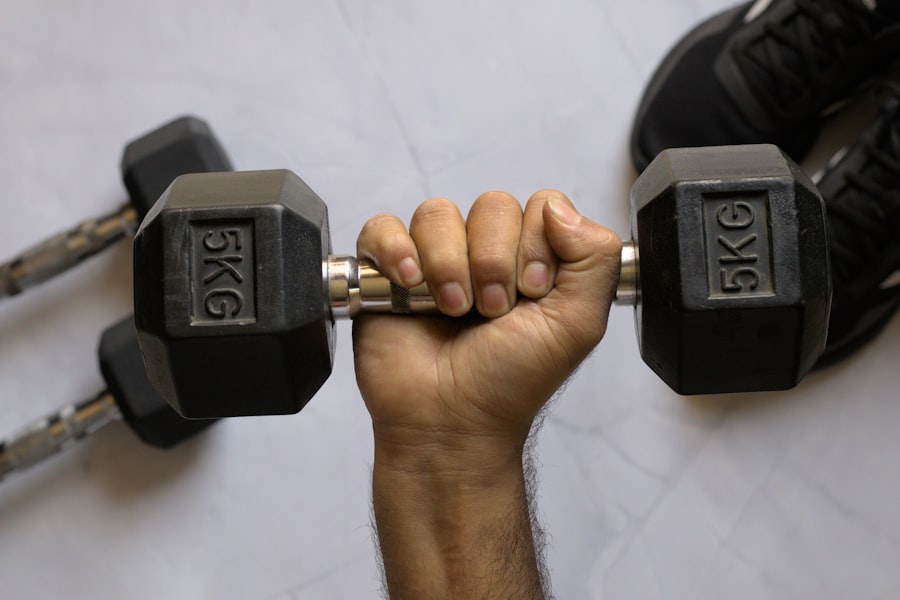Weight training is often perceived as an activity reserved for seasoned athletes or bodybuilders, but its benefits extend far beyond that narrow scope. For beginners, engaging in weight training can serve as a foundational element for overall health and fitness. One of the most significant advantages is the enhancement of muscle strength and endurance.
As individuals embark on their fitness journey, building muscle not only improves physical appearance but also boosts metabolism, which can aid in weight management. Increased muscle mass leads to a higher resting metabolic rate, meaning that the body burns more calories even at rest. This metabolic boost is particularly beneficial for those looking to lose weight or maintain a healthy body composition.
Moreover, weight training plays a crucial role in improving bone density, which is especially important as individuals age. Osteoporosis, a condition characterized by weak and brittle bones, can be mitigated through regular resistance training. Studies have shown that weight-bearing exercises stimulate bone formation and slow down the rate of bone loss.
For beginners, incorporating weight training into their routine can lay the groundwork for a healthier future, reducing the risk of fractures and other bone-related issues. Additionally, the psychological benefits of weight training cannot be overlooked; many beginners report increased confidence and improved mood as they witness their strength and physical capabilities grow.
Key Takeaways
- Weight training is important for beginners to build strength, increase metabolism, and improve overall health and fitness.
- Basic weight training equipment includes dumbbells, barbells, and resistance bands, and techniques include exercises like squats, deadlifts, and bench presses.
- Beginners should set realistic goals and create a workout plan that includes a variety of exercises targeting different muscle groups.
- Understanding proper form and technique is crucial to prevent injury and maximize the effectiveness of weight training exercises.
- Safety tips for beginners include warming up, using proper equipment, and listening to your body to prevent injury.
Basic Weight Training Equipment and Techniques
When starting a weight training regimen, understanding the basic equipment available is essential for effective workouts. Beginners often find themselves overwhelmed by the variety of options, but focusing on a few key pieces can simplify the process. Dumbbells are one of the most versatile tools available; they can be used for a wide range of exercises targeting different muscle groups.
Adjustable dumbbells allow users to modify the weight according to their strength level, making them ideal for progressive overload—a principle that is vital for muscle growth. Another fundamental piece of equipment is the barbell, which can be used for compound movements such as squats, deadlifts, and bench presses. These exercises engage multiple muscle groups simultaneously, promoting overall strength development.
Resistance bands are also an excellent addition to a beginner’s toolkit; they provide variable resistance and can be used for both strength training and rehabilitation exercises. Understanding how to use these tools effectively is crucial; beginners should familiarize themselves with basic techniques such as grip positioning and body alignment to maximize their workouts.
Setting Realistic Goals and Creating a Workout Plan

Establishing realistic goals is a critical step for beginners embarking on their weight training journey. Goals should be specific, measurable, achievable, relevant, and time-bound (SMART). For instance, rather than setting a vague goal like “get stronger,” a more concrete objective would be “increase my bench press by 10 pounds in three months.” This specificity not only provides direction but also allows individuals to track their progress effectively.
Setting short-term goals can also help maintain motivation; celebrating small victories along the way fosters a sense of accomplishment that encourages continued effort. Creating a structured workout plan is equally important for beginners. A well-rounded program should include a mix of exercises targeting all major muscle groups—chest, back, legs, shoulders, arms, and core—ensuring balanced development.
Beginners might start with two to three full-body workouts per week, gradually increasing frequency as they become more comfortable with their routine. Incorporating rest days is essential for recovery and muscle growth; overtraining can lead to burnout or injury. A sample workout plan might include exercises like squats, push-ups, bent-over rows, and planks, with each session lasting around 45 minutes to an hour.
Understanding Proper Form and Technique
| Exercise | Proper Form and Technique |
|---|---|
| Squats | Keep your back straight, chest up, and knees behind your toes |
| Deadlifts | Engage your core, keep your back flat, and lift with your legs |
| Push-ups | Keep your body in a straight line from head to heels and lower your chest to the ground |
| Shoulder Press | Keep your back straight, engage your core, and press the weight overhead with control |
Mastering proper form and technique is paramount in weight training, especially for beginners who may be unfamiliar with various movements. Incorrect form not only diminishes the effectiveness of an exercise but also significantly increases the risk of injury. For instance, during a squat, failing to keep the knees aligned with the toes can lead to knee strain or injury over time.
Beginners should prioritize learning the correct mechanics of each exercise before increasing weights or intensity. Utilizing mirrors in the gym or seeking guidance from experienced trainers can provide valuable feedback on form. In addition to visual cues, understanding body alignment and movement patterns is essential.
For example, when performing a deadlift, maintaining a neutral spine throughout the lift is crucial to prevent back injuries. Beginners should focus on engaging their core muscles to support their spine during lifts. Many gyms offer introductory classes or personal training sessions that emphasize proper technique; taking advantage of these resources can accelerate learning and instill confidence in new lifters.
Furthermore, video tutorials from reputable fitness professionals can serve as helpful references for practicing at home.
Safety Tips and Injury Prevention
Safety should always be a top priority when engaging in weight training, particularly for beginners who may not yet be familiar with their limits or the equipment being used. One of the most effective ways to prevent injuries is to start with lighter weights and gradually increase resistance as strength improves. This approach allows the body to adapt to new stresses without overwhelming it.
Additionally, warming up before workouts is essential; dynamic stretches and light cardio can prepare muscles and joints for more intense activity. Another critical aspect of safety is listening to one’s body. Beginners should be aware of any discomfort or pain during exercises; distinguishing between normal muscle fatigue and potential injury is vital.
If something feels off, it’s important to stop and reassess rather than pushing through pain. Using proper equipment—such as weightlifting shoes that provide stability and grip—can also enhance safety during workouts. Finally, incorporating rest days into a training schedule allows muscles to recover and rebuild, further reducing the risk of overuse injuries.
Incorporating Cardio and Flexibility Training

While weight training is an excellent way to build strength, incorporating cardiovascular exercise into a fitness routine offers additional health benefits that complement resistance training. Cardio workouts improve heart health, increase endurance, and aid in calorie burning—factors that are particularly beneficial for beginners looking to lose weight or improve overall fitness levels. Activities such as running, cycling, swimming, or even brisk walking can be integrated into a weekly schedule alongside weight training sessions.
Flexibility training is another crucial component that should not be overlooked. Stretching exercises enhance range of motion and reduce muscle stiffness, which can improve performance during weight training sessions. Incorporating dynamic stretches before workouts prepares muscles for activity, while static stretching post-workout aids in recovery by promoting blood flow to fatigued muscles.
Yoga or Pilates classes can also be excellent ways to improve flexibility while providing additional core strength benefits.
Nutrition and Recovery for Weight Training Beginners
Nutrition plays an integral role in supporting weight training efforts for beginners. Consuming a balanced diet rich in protein, carbohydrates, and healthy fats is essential for fueling workouts and promoting recovery. Protein intake is particularly important for muscle repair and growth; sources such as lean meats, fish, eggs, legumes, and dairy products should be included in daily meals.
Carbohydrates provide the necessary energy for intense workouts, while healthy fats support overall health and hormone production. Recovery strategies are equally important in a beginner’s weight training journey. Adequate sleep is crucial for muscle recovery; during sleep, the body undergoes repair processes that are vital for growth and adaptation to training stimuli.
Hydration cannot be overlooked either; drinking enough water before, during, and after workouts helps maintain performance levels and supports recovery processes. Additionally, incorporating rest days into a workout routine allows muscles time to heal and grow stronger.
Tracking Progress and Making Adjustments to Your Routine
Tracking progress is an essential practice for beginners engaged in weight training; it provides tangible evidence of improvements over time and helps maintain motivation. Keeping a workout journal or using fitness apps can assist individuals in recording their exercises, weights lifted, sets completed, and personal bests achieved. Regularly reviewing this data allows beginners to identify patterns in their performance and recognize areas that may require adjustments.
As individuals progress in their weight training journey, making adjustments to their routine becomes necessary to continue challenging the body and avoiding plateaus. This could involve increasing weights lifted, changing exercise variations, or altering workout frequency. Additionally, incorporating different training styles—such as circuit training or supersets—can introduce variety into workouts while keeping them engaging.
By remaining adaptable and open to change, beginners can ensure continued progress toward their fitness goals while enjoying the journey along the way.
FAQs
What is weight training?
Weight training is a form of exercise that uses resistance to strengthen and build muscle. It typically involves using free weights, weight machines, or resistance bands to target specific muscle groups.
Is weight training suitable for beginners?
Yes, weight training can be suitable for beginners as long as they start with light weights and focus on proper form and technique. It’s important for beginners to gradually increase the weight as they build strength and confidence.
What are the benefits of weight training for beginners?
Weight training for beginners can help improve muscle strength, increase bone density, boost metabolism, and enhance overall physical performance. It can also help with weight management and improve overall body composition.
How often should beginners do weight training?
Beginners should aim to do weight training exercises 2-3 times per week, allowing for rest days in between sessions to allow the muscles to recover and grow. It’s important to start with lighter weights and gradually increase the intensity as strength improves.
What are some basic weight training exercises for beginners?
Some basic weight training exercises for beginners include squats, lunges, deadlifts, chest presses, shoulder presses, bicep curls, tricep dips, and bent-over rows. It’s important to start with light weights and focus on proper form and technique to avoid injury.
Are there any safety tips for beginners starting weight training?
Yes, beginners should always warm up before starting a weight training session to prepare the muscles and reduce the risk of injury. It’s also important to start with lighter weights and gradually increase the intensity as strength improves. Proper form and technique are crucial to prevent injury, so beginners may benefit from working with a certified personal trainer to learn the correct way to perform exercises.
